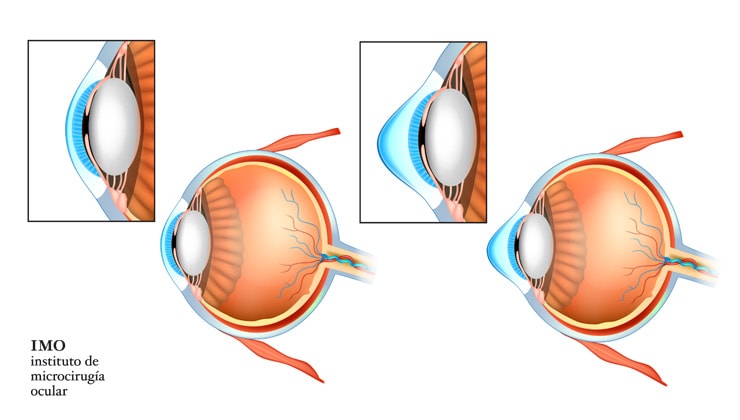What is keratoconus?

Keratoconus is an eye disorder in which the central or paracentral area of the cornea progressively thins. Its usual spherical shape becomes conical, causing irregular astigmatism that distorts images, and a subsequent decrease in vision.
Keratoconus is one of the main reasons for corneal transplant surgery in young patients.
What causes it?
Keratoconus is passed from parents to children in approximately 25% of cases. In the remaining cases, it appears sporadically, linked to complex patterns of inheritance that are the subject of ongoing research.
There are also cases related to eye allergies or continuous rubbing of the eyes.
How can it be prevented?
There are no preventative measures for keratoconus, but there are treatments available to arrest its development. Early detection is essential to prevent the disorder from advancing and requiring corneal transplant surgery.
There are also mild forms that do not cause visual impairment and can only be diagnosed through topographic examination.
It is recommended that relatives of keratoconus patients, although not appearing to be affected, undergo a visual examination, as they may be carriers of the disease.
Most at risk of keratoconus are children and young people, so it is important to encourage these age groups to have regular eye examinations.
Symptoms

The main symptom is decreased vision and the onset or sudden increase of astigmatism.
Astigmatism is normally induced by a refractive defect in the cornea which, unlike myopia or hyperopia, does not tend to develop naturally with age.
It is therefore important for any patient suffering from a sudden increase in refractive defect, especially if children or young people, to have a complete topographic examination to rule out the presence of keratoconus.
Associated treatments
There are several treatment options available depending on the severity of the disease:
In mild cases of keratoconus, good vision can be achieved through correction with glasses.
In more advanced cases, hard contact lenses are required to correct irregular astigmatism.
In some cases, it may be necessary to resort to surgical treatments, such as intrastromal corneal rings to stabilise the cornea, or corneal cross-linking, a procedure that has proven highly effective in slowing down the progression of keratoconus.
In more severe cases, when vision has been reduced significantly, the only solution is keratoplasty, also known as corneal transplantation. These days, transplantation can often be performed by selectively replacing the affected layers of the cornea and preserving the healthy tissue.
Specialists who treat this pathology
FAQs
Most patients who suffer rejection of a corneal transplantation experience reduced vision. Other symptoms include the appearance of foreign bodies and being dazzled or bothered by light.
The patient should avoid strenuous activities and, in particular, avoid direct trauma to the eye.
IMO Institute of Ocular Microsurgery
Josep María Lladó, 3
08035 Barcelona
Phone: (+34) 934 000 700
E-mail: international@imo.es
See map on Google Maps
By car
GPS navigator coordinates:
41º 24’ 38” N – 02º 07’ 29” E
Exit 7 of the Ronda de Dalt (mountain side). The clinic has a car park with more than 200 parking spaces.
By bus
Autobus H2: Rotonda de Bellesguard, parada 1540
Autobus 196: Josep Maria Lladó-Bellesguard, parada 3191
Autobuses H2, 123, 196: Ronda de Dalt – Bellesguard, parada 0071
How to arrive at IMO from:
IMO Madrid
C/ Valle de Pinares Llanos, 3
28035 Madrid
Phone: (+34) 910 783 783
See map in Google Maps
Public transport
Metro Lacoma (líne 7)
Autobuses:
- Lines 49 & 64, stop “Senda del Infante”
- Line N21, stop “Metro Lacoma”
Timetables
Patient care:
Monday to Friday, 8 a.m. to 8 p.m.
IMO Andorra
Av. de les Nacions Unides, 17
AD700 Escaldes-Engordany, Andorra
Phone: (+376) 688 55 44
See map in Google Maps
IMO Manresa
C/ Carrasco i Formiguera, 33 (Baixos)
08242 – Manresa
Tel: (+34) 938 749 160
See map in Google Maps
Public transport
FGC. Line R5 & R50 direction Manresa. Station/Stop: Baixador de Manresa
Timetables
Monday to Friday, 08:30 A.M – 13:30 PM / 15:00 PM – 20:00 PM











